Dwanna L. McKay outlines the historic injustice that was corrected by the Supreme Court.
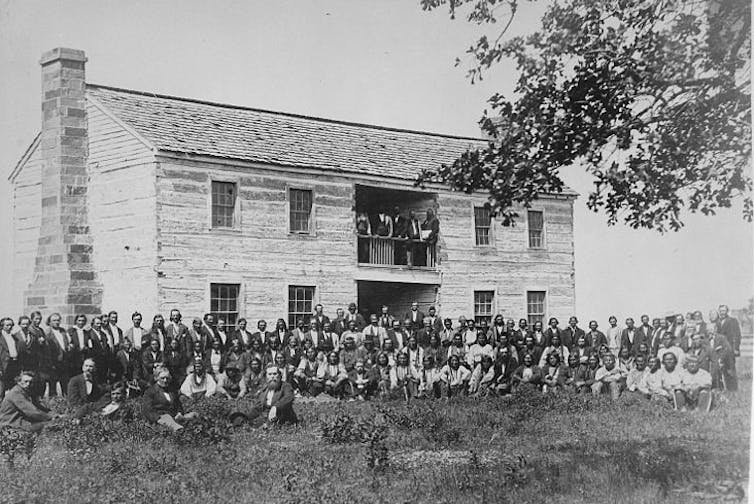
By Dwanna L. McKay
Colorado College
 Some Oklahomans are expressing trepidation about the Supreme Court’s recent ruling that much of the eastern part of the state belongs to the Muscogee (Creek) Nation. They wonder whether they must now pay taxes to or be governed by the Muscogee.
Some Oklahomans are expressing trepidation about the Supreme Court’s recent ruling that much of the eastern part of the state belongs to the Muscogee (Creek) Nation. They wonder whether they must now pay taxes to or be governed by the Muscogee.
In alarmist language, Sen. Ted Cruz of neighboring Texas tweeted that the Supreme Court “just gave away half of Oklahoma, literally. Manhattan is next.”
In fact, the landmark July 9 decision applies only to criminal law. It gives federal and tribal courts jurisdiction over felonies committed by tribal citizens within the Creek reservation, not the state of Oklahoma.
Any shock that tribal nations have sovereignty over their own land reflects a serious misunderstanding of American history. For Oklahoma – indeed, all of North America – has always been, for lack of a better term, Indian Country.
‘Indian Country’
As both an educator and scholar, I work to correct the erasure of indigenous histories through my research and teaching.
North America was not a vast, unpopulated wilderness when white colonizers arrived in 1620. Up to 100 million people of more than 1,000 sovereign indigenous nations occupied the area that would become the United States. At the time, fewer than 80 million people lived in Europe.
________________________________________________________________________________________________
Consortium News Editor-in-Chief Joe Lauria appeared on the Fault Lines radio show to explain how the reaction to the Supreme Court’s decision was overblown, and how the ruling merely allows tribal courts to try only tribal members for non-federal offenses.
________________________________________________________________________________________________
America’s indigenous nations were incredibly advanced, with extensive trade networks and economic centers, superior agricultural cultivation, well developed metalwork, pottery and weaving practices, as historian Roxanne Dunbar-Ortiz has comprehensively detailed.
Unlike Europe, with its periodic epidemics, North America had little disease, Dunbar-Ortiz says. People used herbal medicines, dentistry, surgery and daily hygienic bathing to salubrious effect.
Historically, indigenous nations emphasized equity, consensus and community. Though individualism would come to define the United States, my research finds that Native Americans retain these values today, along with our guiding principles of respect, responsibility and reciprocity.
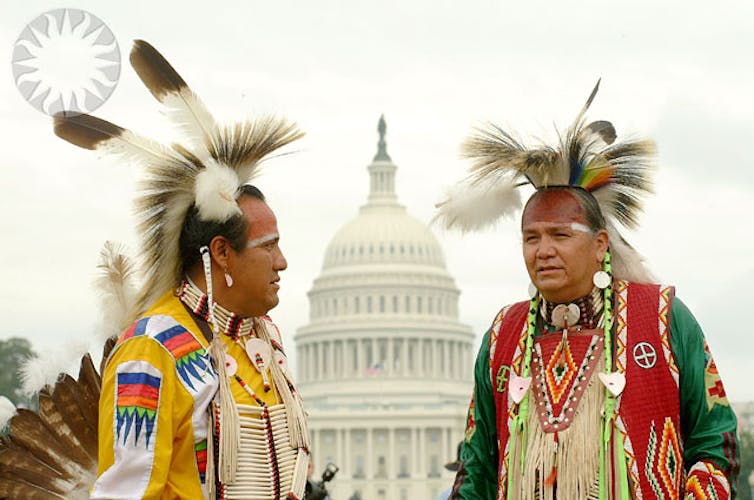
Broken Promises & Stolen Lands
European and American colonizers did not hold these same values. From 1492 to 1900, they pushed inexorably westward across the North American continent, burning Native villages, destroying crops, committing sexual assaults, enslaving people and perpetrating massacres. The government did not punish these atrocities against indigenous nations and their citizens.
Citing the so-called Doctrine of Discovery and Manifest Destiny, U.S. policymakers argued that the federal government had a divine duty to fully develop the region. Racist in language and logic, they contended that “Indians” did not know how to work or to care for the land because they were inferior to whites.
Oklahoma was born of this institutionalized racism.
Under the Indian Removal Act of 1830, the Cherokee, Chickasaw, Choctaw, Creek and Seminole nations – known as the Five Tribes – were forced from their ancestral homelands in the southeast and relocated to “Indian Territory,” as Oklahoma was then designated. Half of the Muscogee and Cherokee populations died from brutal and inhumane treatment as they were forcibly marched 2,200 miles across nine states to their new homelands in what most Americans call the Trail of Tears.
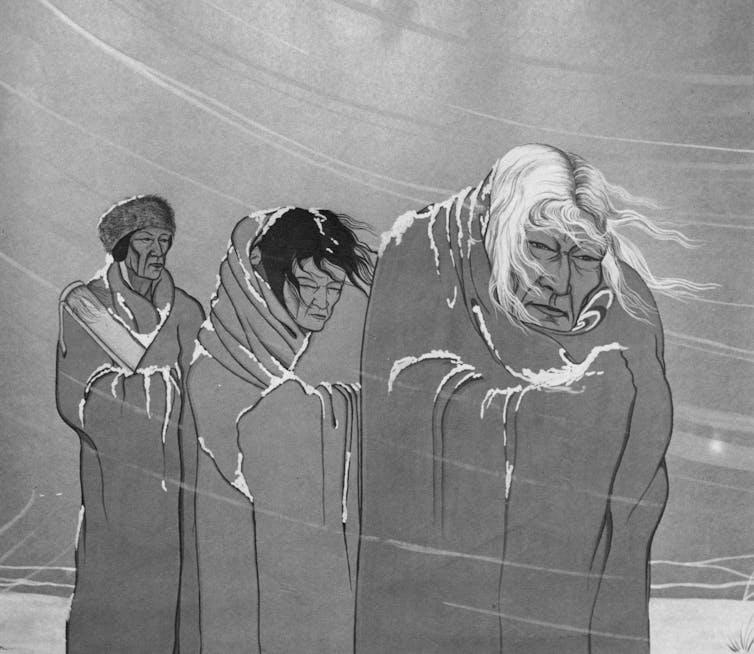
(Al Moldvay/The Denver Post via Getty Images)
Indian Territory, which occupied all Oklahoma minus the panhandle, was almost 44 million acres of fertile rolling prairies, rivers and groves of enormous trees. Several Indian nations already lived in the area, including the Apache, Arapaho, Comanche, Kiowa, Osage and Wichita.
Legally, Indian Territory was to belong to the tribal nations forever, and trespass by settlers was forbidden. But over the next two centuries, Congress would violate every one of the 375 treaties it made with Indian tribes as well as numerous statutory acts, according the United States Commission on Civil Rights.
By 1890, only about 25 million acres of Indian Territory remained. The Muscogee lost nearly half their lands in an 1866 Reconstruction-era treaty. And in 1889, almost 2 million acres in western Oklahoma were redesignated as “Unassigned Lands” and opened to “white settlement.” By 1890, the U.S. Census showed that only 28 percent of people in Indian Territory were actually “Indian.”
With statehood in 1907, Oklahoma assumed jurisdiction over all its territory, ultimately denying that the Muscogee had ever had a reservation there. That is the historic injustice corrected by the Supreme Court on July 9.
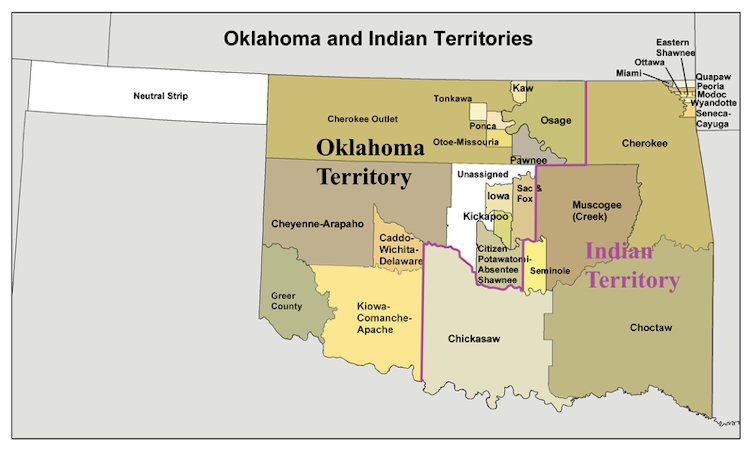
(Kmusser/Wikimedia Commons, CC BY)
Respect, Responsibility & Reciprocity
Despite all the brutality and broken promises, the Five Tribes have contributed socially, culturally and economically to Oklahoma far beyond the shrinking bounds of their territories, in ways that benefit all residents.
The public school system created by the Choctaws shortly after their arrival became the model for Oklahoma schools that exists today. Last year, Oklahoma tribes contributed over $130 million to Oklahoma public schools.
Oklahoma tribes also enrich the state’s economy, employing over 96,000 people – most of them non-Native – and attracting tourists with their cultural events. In 2017, Oklahoma tribes produced almost $13 billion in goods and services and paid out $4.6 billion in wages and benefits.
The Muscogee (Creek) Nation, in particular, invests heavily in the state, creating businesses, building roads and providing jobs, health care and social services in 11 Oklahoma counties.
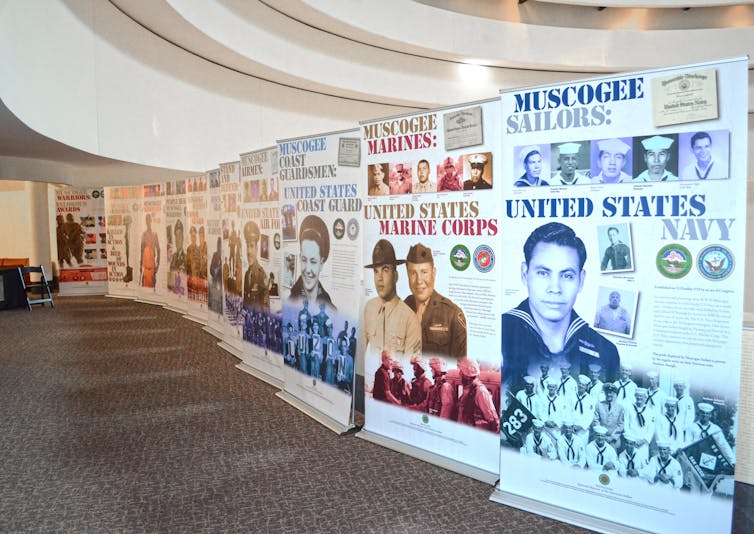
Still Our Homelands
Citizens of the Five Tribes have also contributed to broader American society.
Before the Navajo Code Talkers of World War II, the Choctaw Code Talkers used their language as code for the United States in World War I. Lt. Col Ernest Childers, a Muscogee, won the Medal of Honor for his service in World War II. U.S. Poet Laureate Joy Harjo, also a Muscogee, is the first indigenous poet laureate. Mary Ross, a Cherokee, was the first known indigenous female engineer. And John Herrington, Chickasaw, was a NASA astronaut. These are but a few examples.
The strong collaborative leadership of the Muscogee (Creek) Nation was apparent after the Supreme Court’s ruling in Principal Chief David Hill’s official response.
“Today’s decision will allow the Nation to honor our ancestors by maintaining our established sovereignty and territorial boundaries,” Hill said, adding: “We will continue to work with federal and state law enforcement agencies to ensure that public safety will be maintained.”![]()
Dwanna L. McKay is assistant professor of race, ethnicity and indigenous studies at Colorado College.
This article is republished from The Conversation under a Creative Commons license. Read the original article.
Please Contribute to Consortium
News on its 25th Anniversary
Donate securely with  PayPal here.
PayPal here.
Or securely by credit card or check by clicking the red button:

The very Constitution oc Us is largely based upon native american tribal so ieties agreements between tribes and stolen ideals by our forefathers at founding with huge influence of Ben Franklin and Thomas JeffersonAmong msny of what whites called civilized tribals femalrx had more rights than european whitr wen.
at Huron Councils any one, male or female. could. Ask for vote of confodence on tribal elder, msny were female, by just walking up during meeting and removingg elders feather.
Long forgptten is Cherokee were quite wealthy and owned slaves they took with them who died on trail.Those blacks and mixed were not allowed to be on tribal registry until within last 10 years limiting their full shares of tribal benefits.
LAWS OF DISCOVERY: AS MENTIONED HERE. Is it delibertly left vague, was Maritime agreements not teritorial as put forth by Spain, France, Btitain, Catholic Chur ch.Dutch and French.
It only allowed di overing matiom “Trading and Tresty ability ” with original owners natives and wss mostly used by discovery of Water ways and proples along them.
When France sold US Louisiana Purchace they were not selling lands as they did not own other than at most.ly many mall trading post purchased with trade goods; They ” sold quit claims. To trade and treaty rights with natives ” from ocean to and along Mississippipi and all its tributarys.
The purchase of Alaska gfrom a Russian Duke, not actual government, was of a Granted Discovery of trade to Duke by Russian Royals but not the lands.
US history can be described as an avarice to the extrem. With a strong genocidal trait we can stiill see in todays US militaristic destruction of many nations. Genocide is not just physical destruction of bodies it is an erasure of all cultural traits traditions religions of a nation and its peoples past.
Since I am now editing a fiction story I wrote set in the southeast circa 1650 I felt compelled to comment here.
The author, Dwanna L. McKay writes well, and she has a legitimate bone to pick, but she is coming off as a zealot.
Baby boomers have tended to almost worship the Indians as if they were all and only spiritual, when in fact, many tribes spent plenty of their time in warfare, the torture of captives (by both men & women), slavery, and even (rarely) human sacrifice.
I’m not pumping my book here, but the theme is relavent–anti-war. The main character, a young native man, simple doesn’t understand why they must always be raiding. He see’s a much greater threat looming (settlers)
I agree with Henry C that it is questionable to lump all First Nations cultures together as if they were the same.
John Chuckman–it’s highly likely that the population # was actually 100 million or so.
I will cut & paste a few relavent excerpts from my un-edited Historical Notes:
800 years ago over 100,000 earthen mounds dotted the North American landscape east of the Mississippi and more to the west. Ranging in breadth from twenty feet to the 951 foot/290 meter Monks Mound in Cahokia, these man-made constructions were used for various purposes, and it seems they were raised specifically for those purposes. Some were obvious burial mounds, others flat-topped, designed to support impressive wooden structures, while some were formed as enigmatic effigy mounds in the shapes of animals, both common and extinct. Many mounds were placed carefully, oriented to align with, and to determine the timing of celestial events, like many prehistoric megalithic structures worldwide.
–Some of the mound cities were huge—central hubs flanked by extensive suburbs.
We do not know the names these cities were known as by the inhabitants of the time. Today the archaeological site we call Moundville in Alabama was once heavily populated. Poverty Point in Louisiana was extensive, with artifacts dating as far back as 3900 B.C. Archaeologists estimate that Cahokia in Illinois boasted a population of over 20,000, more than the 14,000 people living in London, England during the same period in 1200 A.D.
–When some North American native languages were cataloged in the 19th century, linguists were surprised as to the diversity of, and how many different languages were used, many from a handful of linguistic groups, and some unique and completely unrelated to others.
–The idea that the Americas were populated by people migrating for years through the frozen wastes from Asia via the Bering Sea was, and has only ever been a theory—a theory that now, in the 21st century is considered passe by most (but not all) mainstream antiquarians. Wherever the people that populated the Americas originated from, we can now determine the migrations were many, from various sources, and spanning millennia. DNA sequencing has proved very enlightening for many sectors of science. Current archaeology clearly illustrates that there were folks living in both north and south America prior to and during the Younger Dryas Impact Event circa 12,800 years ago.
–However, from DeSoto’s expedition we get a rare snapshot of native societies as they existed at that time. Even though by 1542 the cities had been abandoned for 300 years or so, there were apparently millions of people living along both sides of the length of the Mississippi and beyond. It was like a solid suburb from the bayous in the south extending far to the north.
–Desoto was impressed by the Caddo pottery, remarking that it was the best he’d seen in the country, rivaling any pottery he knew from Europe.
The bottom line folks, is that the sophisticatioon of pre-Columbian Native Americans has been down played, and the Smithsonian for one has wielded a heavy hand in it over the years.
I agree with the author…the duplicity of the US government has been appaling, but if I were to make the command decision as to what to do about the First Peoples in general, I honestly don’t know what I’d do.
Giving them seats in congress would be a great start. You know an honest seat at the table where they can best represent themselves . Something ordered in a fashion to prevent the next racist fascist president from countermanding the law.
Now for something fresh and informative. On pages 47-49 of Gale Richard Walker’s “THE THEFT OF OHIO , 1783-1795, the author relates the work of surveyor William Crawford and his alliance with George Washington.
P49 Washington’s Land Holdings After the War and a Touch of a Feather 1rst paragraph ” . . . . he claimed 49,000 acres in the West . . .,
This would be after the French and Indian War and the west would be the area east of the Mississippi River, not “out west”.
Check it out at amazon
You might want to get hold of a copy because this is real history not told in this manner before.
Note that the tribes pushed out of their homes by Andrew Jackson’s horrendous Trail of Tears were just peaceful established farmers. Their land of course was stolen after they were marched off to what would become Oklahoma.
Note, too, that Andrew Jackson’s picture remains honored on the twenty-dollar bill as well as other places.
Despite killing and effectively stealing from thousands of native people. And despite being an unapologetic slaveholder. And despite having a raging temper, always ready to strike someone who opposed him with a cane or threaten a duel.
A truly brutal man, but there he is honored on the currency, and text books even speak of his time as the Age of Jackson and blubber on about “Jacksonian democracy.”
He and ultra-hypocrite Jefferson are two of the most glaring examples of how American history is molded and manipulated to build good little Patriots.
Very good article, as far as it relies on documented history. I must part company with the following attempts by the author to couch her arguments, in part, in terms of “superiority” of native society and/or culture :
“America’s indigenous nations were incredibly advanced, with extensive trade networks and economic centers, superior agricultural cultivation, well developed metalwork, pottery and weaving practices….
Unlike Europe, with its periodic epidemics, North America had little disease…. People used herbal medicines, dentistry, surgery and daily hygienic bathing to salubrious effect.
Historically, indigenous nations emphasized equity, consensus and community. Though individualism would come to define the United States, my research finds that Native Americans retain these values today, along with our guiding principles of respect, responsibility and reciprocity.”
These references detract from an otherwise well written piece. They invite unnecessary counterpoints such as the war like and very much non peaceful nature of certain first peoples such as the Iroquois League, and, the “new world” origin of certain sexually transmitted diseases. It also implies all first people shared a common monolithic culture–which is very much contrary to history and is in itself a form of self defeating stereotyping.
Why the need to make unnecessary racial and cultural comparisons, when the history of a long line of broken treaties and racism alone are sufficient. Countering such history –with counter stereotypes–is problematic logic at best, and lamentable. given the story is otherwise nicely written and convincing.
An excellent survey of some past American relations with Indigenous people.
But there is one point I wonder about.
“North America was not a vast, unpopulated wilderness when white colonizers arrived in 1620. Up to 100 million people of more than 1,000 sovereign indigenous nations occupied the area that would become the United States.”
100 million just seems an extraordinarily large number. The population of the US didn’t reach 100 million until the early part of the 20th century.
As to their sophistication there can be no doubt. I have seen some of the striking remains of the Anasazi.
I live in Apalachicola, Florida, a city named for the local tribe who were part of the extended Apalachee group of the Florida Panhandle. Local history shows that, leveraged by a Spanish land grant, the Forbes Company seized Apalachicola lands to pay debts supposedly accrued by the tribe to the trading company (probably an illicit, illegal operation), and were moved to Oklahoma, whence they disappeared from history. I have always wondered what happened to these people.
“Congress would violate every one of the 375 treaties it made with Indian tribes as well as numerous statutory acts,”
Not honoring agreements seems to be as “American” as apple pie.
There’s a spectacular and devastating book on the subject, Killers Of The Flower Moon by David Grann about the horrendous theft of Oklahoma’s oil. The now rich whites murdered, lied, stole, and committed every imaginable kind of treachery to rip the oil rights from the Indians. It’s a read that every American should read in school.
In the forward to her novel Cimarron, published in 1929, Edna Ferber wrote: “Only the more fantastic and improbable events in this book are true. . . In many cases material entirely true was discarded as unfit for use because it was so melodramatic, so absurd as to be too strange for the realm of fiction . . . Anything can have happened in Oklahoma. Practically everything has.”
And now, current events in Oklahoma continue to validate Edna Ferber’s wisdom.